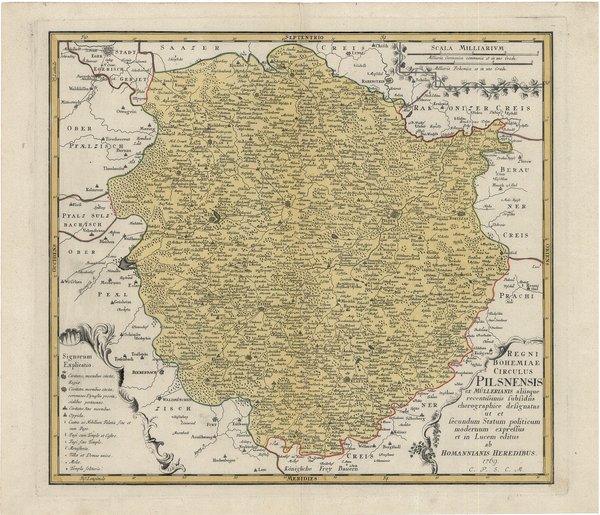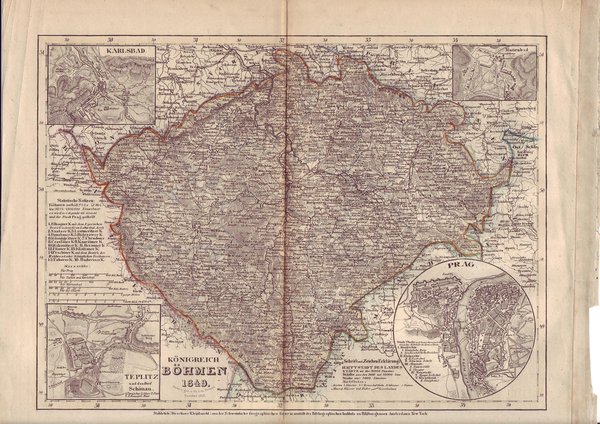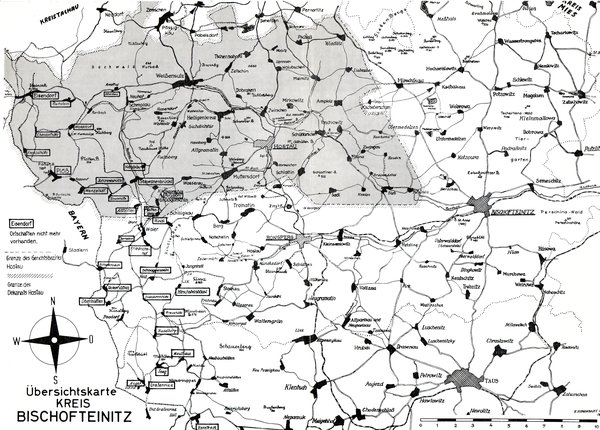Upstream on the Radbusa before you get into the town of Hostau you will reach the historically interesting village of Schüttarschen with its 1600 feet high Mount Saint Laurence. On its top there is the Church of Saint Laurence surrounded by a fivefold rampart. The church was built in the 11th century at the place of a Pre-Christian cult site. During excavations human skeletons in sitting position were discovered, along with animal bones, urns, rings and clips of bronze, pots of clay and also silver coins from the time of the Bohemian Duke Wratislaw II. (1061-1086). Many things of this historical site were transferred to a museum in Prague. This mount does not only have a rich past, it is a beautiful vista point as well to view a blessed farm land with green hayfields in the Radbusa-Valley, billowing grain fields on the lowlands and even slopes of this area. Years ago also iron ore and sulfur gravel were mined, but due to small productivity it was discontinued.
Westwards of it there is the beautiful area of Hostau, Muttersdorf and Weißensulz. These towns were all similar in a rural architecture and middle-class behavior. Professional farming played nearly the great role as for the surrounding rural population. Besides that there was also a modest trade, which had the local community as customers. A larger industrial deal could also be recognized. In Muttersdorf and Weißensulz subtle laces were produced, in Hostau stoneware. The people of Muttersdorf had started to mine the syenit existing northeast of the town. Excellent mirrors were delivered to the whole region. Also mining on copper, which began in the 16th century, got a new stimulation. Therefore the commercial work did not step determining into the foreground. But nowhere did trades play the important role. In all towns the state of an unhurried life was predominant as in most villages of Bohemian forest.
Northwest of Hostau the Radbusa-Valley narrows between the black mountain (1939 feet) and the castle mountain. Framed by wooden hills in a southwest side valley there is the village of Heiligenkreuz. After changing owners the dominion was transferred to the Barons Kotz of Dobrz around 1800. The main source of income here was mixed farming.
South of Hostau there is Ronsperg. The small town, found in 14th century, has an interesting history, which unfortunately was affected badly by the tragedy of the Second World War. For a long time German, Czechs and a numerous Jewish community have been living here together. For Jews, Ronsperg was even a place of pilgrimage well known in all of Europe. In the local castle under the rule of Heinrich Count Coudenhove-Kalergi, the Japanese wife of this well-known Austrian diplomat, lived in the years 1896 - 1918. Additionally, under the perception of the failed re-organization of Europe after the First World War, and the refusal on the League of Nations by the U.S., the young political philosopher Richard Coudenhove-Kalergi was convinced that only a federal union of the European continent could prevent a Second World War west of Russia. Only a unified Europe is able to protect itself militarily against a Russian threat and economically from the increasing American competition. No statesman at that time was eager on his ideas. And as there were also no signs for a unified Europe in the beginning, Coudenhove decided in 1922 to establish the Paneuropa movement by himself. Since 1972 he has been followed as international president of the Paneuropa Union by His Highness Otto of Habsburg.



